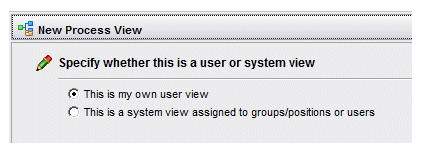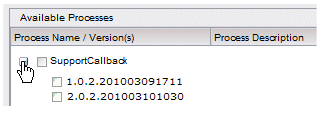Creating Process Views
A wizard is provided to create a new process view.
Procedure
-
Click the
Create New View button (
 ) on the process view list menu bar (or select
New from the
Tools
menu).
) on the process view list menu bar (or select
New from the
Tools
menu).
-
Choose the type of process view to create:
- A
user view is one that you create to list process instances filtered and sorted as desired.
If you are creating a user view, select This is my own user view, then click Next.
- A
system view is one that is automatically available to specified users, or to users that have been assigned to specific groups or positions.
Creating a system view is typically a supervisory or administrative function. Therefore, the discussion of creating a system view is provided in a separate section of the documentation.
If you are creating a system view, select This is a system view assigned to groups/positions or users, which causes additional items to be displayed on the dialog. Refer to the information in System Views to complete that dialog, then return to this step to complete the creation of the process view.
- A
user view is one that you create to list process instances filtered and sorted as desired.
-
Complete the
New Process View
dialog as follows:
- Enter the desired name for the process view in the Name field.
- Optionally enter a description for the process view in the Description field(1).
-
Select one of the following options to specify the process instances that will appear in the view:
- Include selected processes - Selecting this option causes the list of processes that currently exist on the server to be displayed (as in the example above). This allows you to select the desired processes whose instances you want to appear in the process view you are creating.
- Include all processes - Selecting this option causes
all processes to be included in the view, which in turn causes
all instances of those processes to appear in the process instance list when the view is selected.
If you select this option, the process view you are creating will include all instances of all processes that exist when the view is selected, not when the view was created. Note that this is an important distinction from selecting the Include selected processes option and adding all of the processes to the view — when that process view is selected, the process instance list will include the instances from all of the processes that existed when the view was created, not when it is selected. If new processes are added to the system, a process view created with the Include all processes option selected will include those processes as well.
Note that the default “All Instances” process view has the Include all processes option selected by default.
If you select the Include all processes option, the list of processes on the Select Processes to include in the View dialog goes away, since you don’t need the list to select from. If you selected this option, proceed to step 3e.
-
Select the process(es) whose instances you would like to appear in the process view you are creating.
You can expand each of the processes to list all of the versions that are available for that process by clicking the
 button:
button:
You can select processes you want to include in the process view in the following ways:
- Clicking the boxes to the left of the version numbers selects only those specific versions.
- Clicking a top-level box (i.e., next to the process name) causes all versions of the process to automatically be selected. Note that if you select the top-level box, it causes all future versions of the process to also be included in the process view.
-
Choose whether you are creating a standard instance view or a halted instance view by selecting the appropriate option (note that these options appear on the dialog only if you have the appropriate user access authority):
- A
standard instance view is one in which you will see the normal information about process instances. This type of process view does
not, however, include
details about halted processes instances (although it does list halted instances, just not the detail information).
This option may also provide (depending on your user access authority) sub-selections to specify that the standard instance view contain only active instances, only terminal state instances, or both. Terminal state instances are those that have a status of Completed or Cancelled. Note that your system would need to be configured by an Administrator to show Completed and Cancelled process instances; they may be automatically purged, depending on configuration.
- A
halted instance view contains attributes that provide information about why a process instance has become halted. This is a special-use process view that is typically only used by supervisory personnel for troubleshooting halted process instances.
For more information about halted process instances, see Halted Process Instances.
- A
standard instance view is one in which you will see the normal information about process instances. This type of process view does
not, however, include
details about halted processes instances (although it does list halted instances, just not the detail information).
- After selecting the desired processes/versions and choosing the type of process view to create, you can do one of the following:
-
From the Filter dialog, you can do one of the following:
- Enter filter criteria for the view, then click Next to advance to the Sort dialog to specify how to sort the process instances in the view, then to the Column dialog to specify the columns to display in the view.
- Enter filter criteria for the view, then click Finish if you have no desire to either specify how to sort the process instances in the view, nor to specify the columns in the view.
- Click
Next to advance directly to the Sort dialog if you have no desire to specify filter criteria.
Note that any filter criteria you specify through the wizard is considered the “base” filter for the process view (as opposed to a “refined” filter that is set through the Filter function on the process instance list). For more information, see Base Filter and Refined Filter.
Because filtering process instance lists is basically the same as filtering other types of lists in Workspace (with the exception of the specific attributes on which you can filter), details of filtering is explained in a single chapter — see Filtering Lists.
-
From the Sort dialog, you can do one of the following:
- Enter sort criteria for the view, then click Next to advance to the Column dialog to specify the columns to display in the view.
- Enter sort criteria for the view, then click Finish if you have no desire to specify columns for the view.
- Click
Next to advance directly to the Column dialog if you have no desire to specify sort criteria.
Because sorting process instance lists is basically the same as sorting other types of lists in Workspace (with the exception of the specific attributes on which you can sort), details of sorting is explained in a single chapter — see Work Items.
-
From the
Specify Display Columns for the View dialog, move the columns you would like displayed in the view to the list on the right, then click
Finish to complete the creation of the view.
This dialog works in the same way as the Column Selector dialog available from all other lists in Workspace. For information about using the Column Selector, see Customizing Columns in a List.
Also note that if multiple processes were selected to be included in the process view, the columns listed on the Specify Display Columns for the View dialog will only include the intersection of the columns from all of the selected processes. In other words, it will list only the columns that appear in every process included in the view.
You cannot use any of the four following characters in the view name or description: < (less than), > (greater than), & (ampersand), or " (double quote). The application will not allow you to enter any of these characters.


